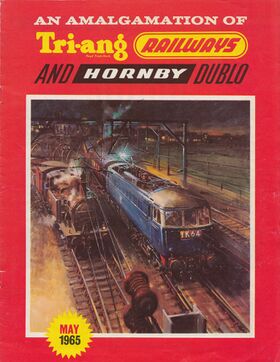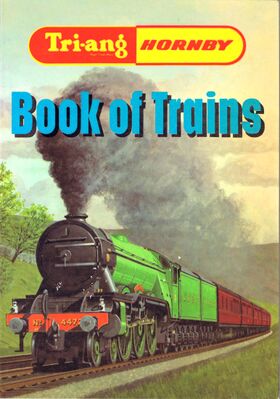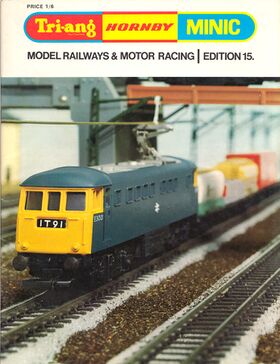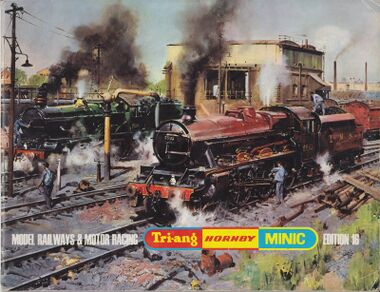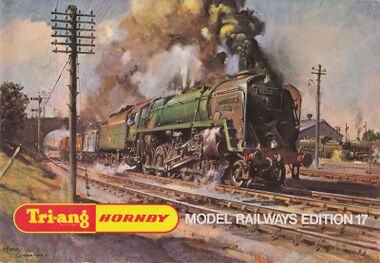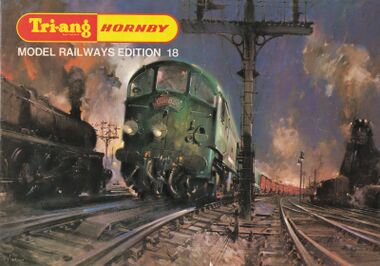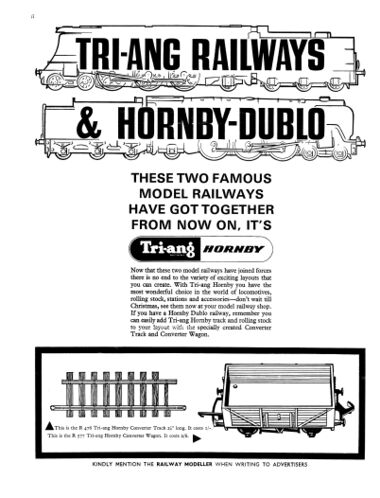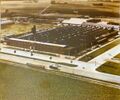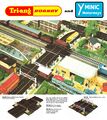Category:Tri-ang Hornby
| Toy Brands and Manufacturers |
|---|
Tri-ang Hornby |
| ~1964 - ~1972 |
1965: Eight-page catalogue brochure for the new Tri-ang Hornby range [image info]
1968 and 1969: Tri-ang Hornby Book of Trains, echoing the old Hornby Book of Trains catalogues produced by Meccano Ltd in the 1930s [image info]
1969: Tri-ang Hornby catalogue, Edition 15, "Model Railways and Motor Racing" [image info]
1970: Tri-ang Hornby catalogue, Edition 16, "Model Railways and Motor Racing", with artwork by Terence Cuneo [image info]
1971: Tri-ang Hornby catalogue, Edition 17, "Model Railways", with artwork by Terence Cuneo [image info]
1972: Tri-ang Hornby catalogue, Edition 18, with artwork by Terence Cuneo [image info]
Tri-ang Hornby, and adaptor wagons and track, advert from the inside front cover of Railway Modeller, October 1965. although the advert says that "these two model railways have joined forces", in effect, the purpose of the adaptor pieces was to allow Triang to sell the existing Dublo legacy stockpile alongside their Triang range without labelling it as obsolete, and to help existing Dublo users to make the transition to being Triang customers. [image info]
Triang Hornby was the model railway range that resulted from the Lines Brothers' takeover of Meccano Ltd. in the mid-1960s.
The end of Hornby Dublo
Meccano Ltd's Hornby Dublo range was expensive and losing money, and it's rumoured that production had already shut down some time before Lines Brothers took over, due to the amount of unsold stockpiled production that had been building up in the warehouse space.
Lines Brothers already had a model railway line - Triang Railways - based on the plastic model railway range produced by their Rovex Plastics subsidiary. The Triang Railways range was a lot cheaper to make than the expensive diecast Dublo range, and although Meccano Ltd had started producing some plastic-bodied wagons, it didn't seem to make financial sense to retool and redesign the Dublo range for plastic when Lines Brothers already had a plastic-moulded railway range that was already in production.
The obvious solution was to announce the merger of the two ranges, as Tri-ang Hornby.
In practice, "Tri-ang Hornby" was the Rovex-based "Tri-ang Railways" range under a fresh name, and was Hornby in name only - some Hornby items survived in the new range (like trackside buildings), but generally, once the existing Dublo stocks were sold, that was it. Although Dublo owners were reassured that the move didn't mean that Dublo was going to be scrapped, in effect it already had been.
I’d spent the previous ten years as Marketing Director of Lines Brothers running Hornby into the ground and then we acquired Meccano and they made me Chairman of Meccano (laughs) so I said to myself am I going to spend a lot more time trying to resuscitate it? So I decided that was ridiculous, but the one thing about Hornby which was internationally known and respected was the name – Hornby, and so we transferred the name to Tri-ang Railways and it became Tri-ang Hornby and we threw out the merchandise so, in fact what you see now under Hornby has no relationship at all to the Hornby product originally it’s entirely Tri-ang Railways but it’s called Hornby.
— Graeme Lines, V&A "British Toymaking" interview , http://www.vam.ac.uk/__data/assets/file/0005/248144/graeme-lines.pdf
Adaptors
As part of the announced merger of the two ranges, Triang did produce adaptor wagons and adaptor track (1965) that allowed the two systems to cooperate, but this was essentially a move to help existing Dublo owners migrate over to the Triang system, and new products then standardised on the use of the Triang couplings and Triang-compatible track connectors - Hornby track, and rolling stock with Hornby couplings, were now regarded as a "legacy" format.
Triang Wrenn
Confusingly, at least some of the Dublo tooling was obtained by Wrenn (in which Lines Brothers owned a stake), and Wren started producing their own updated versions of some of the Dublo pieces. Wren then became officially part of the Lines Brothers empire as Tri-ang Wrenn, which led to the even more confusing situation that while Tri-ang Hornby was called "Hornby" (but wasn't), Triang Wrenn wasn't called "Hornby", but pretty much was.
In the museum
Tri-ang Hornby (as a brand) falls outside the cutoff date that we try to apply to the Museum's display collections, of 1955.
Although we don't have a specific Tri-ang Hornby collection, we //do// have some of the nice Dublo pieces that ended up being incorporated into the early Tri-ang Hornby range, and some of the locomotives and rolling stock that we use and run on the museum's two 00-gauge model railways are Tri-ang Hornby.
Timeline, 1960s-1970s
A review of the contemporary Hornby catalogues shows a complicated sequence of company and branding changes, with a logo that gradually gets less and less like the Triang version
May 1965
The release on an eight-page transitional brochure-catalogue, which explains the merger of the two ranges.
The new "Tri-ang Hornby" logo appears inside, but doesn't appear on the front cover, which shows both logos for the two previous ranges. There's a small Cuneo painting embedded in the front cover.
New products on the back page are a rocket launcher wagon and a satellite launcher, typical of the Tri-ang "novelty" range.
1966– 12th edition
The first catalogue with the "Tri-ang Hornby" logo on the front cover (quite large, showing up well against a dark Cuneo cover. The not-that-successful "Wild West"-style US outline trains go.
1967 – 13th Edition
The company seem to have decided to try to break with tradition, with a white background cover with a light-shaeded embedded painting, and the words "MODEL RAILWAYS" in bold and fairly generic magazine-style text, with the Tri-iang Hornby logo top left. The cover looks like a magazine format, with Triang Hornby as the publisher - was the company feeling a backlash? The 13th Edition text is small, perhaps because the company might not have wanted to stress any "unlucky" connotations.
The novelty range are adapted and re-launched as the "Battlespace" range.
1968 - 14th Edition
The company are now trying to cash in on the 1960s "slot-car" craze.
Another whitish magazine format style cover! Now the publication looks as if it is something called "Railways & Motor Racing", with "MINIC" tacked onto the end of the Triang-Hornby badge, to give a rather ungainly "Tri-ang Hornby Minic" logo. The main picture is split diagonally between trains and racing cars, and the catalogue introduces a range of combined rail and road accessories that allow trains and cars to cross paths.
1968 - Tri-ang Hornby Book of Trains
A reach back to the format of the old 1930s "Hornby Book of Trains", with a mixture of "encyclopaedia-style" train enthusiast content and product catalogue pages, but in portrait format.
1969 - 15th Edition
A white header, now with "Tri-ang Hornby Minic" dominant, above "Model Railways & Motor Racing". Racing cars are now exiled from the front cover in favour fo a photograph of a very plastic-looking 00-gauge diesel. Not an inspiring cover.
"Made in Great Britain by ROVEX INDUSTRIES LTD."
1970 - 16th Edition
After the grim 1969 cover, the company revert to using a Cuneo painting again, and switch to a landscape format more reminiscent fog the old 1930s Mecano Ltd Hornby catalogues. The Triang Hornby Minic logo is still being used, and the description is "Model Railways and Motor Racing".
The company is now listed as "ROVEX Tri-ang Ltd."
1971 - 17th Edition
Trains are good! A specially-commissioned Cuneo painting of the Evening Star steam loco coincides with the launch of the new Evening Star model. This is how Meccano Ltd used to do things in the 1930s!
The catalogue title is now just "Model Railways", and "MINIC" has been dumped from the catalogue logo. The emphasis seems to be to go back to the traditional market, of models of classic steam engines.
The company is still given as ROVEX Tri-ang Ltd. ... but this year, Lines Brothers go into receivership.
1972 - 18th Edition
A Cuneo diesel on the cover.
The company is still given as ROVEX Tri-ang Ltd., for the last time
Post-Tri-ang
- 1973: Branding is now Hornby Railways, and the company listed as ROVEX Limited, with all references to Tri-ang removed.
- 1974: Branding is Hornby Railways, but with a new logo that departs more from the "divided oval" Tri-ang theme, with a broken border that fuses with the tails of the letter "y". The company listing now says "Hornby Railways are manufactured in England by ROVEX Models and Hobbies. A member of the Dunbee-Combex-Marx Group"
- 1975 - as above.
- 1976 - Branding is still Hornby Railways, but the logo changes yet again, and now represents a long octagonal nameplate with a large screwhead at each end. Company details are: "Hornby Railways are manufactured by Hornby Hobbies, Rovex Limited. A member of the Dunbee-Combex-Marx Group". The separate ROVEX logo is no longer being used.
- 1977 – Branding is "Hornby Railways", but the logo has now contracted to a shorter octagonal nameplate with two screwheads, bearing just the single word, "Hornby".
- 1978 – Branding is "Hornby Railways", the nameplate logo now carries the full name again, but now uses upper-case heavy serifed letters, and the four nameplate corners are now curved and concave. Company details as above.
- 1979 – as above, except that logo now has a black border.
- 1980 - Dunbee-Combex-Marx go bust.
- 1982 – Hornby CEO Keith Ness leads a management buyout.
External links
Subcategories
This category has the following 2 subcategories, out of 2 total.
N
Pages in category ‘Tri-ang Hornby’
The following 8 pages are in this category, out of 8 total.
B
Media in category ‘Tri-ang Hornby’
The following 20 files are in this category, out of 20 total.
- Battle Space range, Triang Hornby (THCat 1969).jpg 1,600 × 1,050; 457 KB
- Battle Space range, Triang Hornby (THCat 1970).jpg 1,600 × 1,242; 581 KB
- Hornby Dublo pieces retained in the Triang Hornby range (THMCat 1965).jpg 2,400 × 1,563; 789 KB
- Jenny Lind 1847, Hornby Railways catalogue cover image (HRCat 1975).jpg 2,000 × 1,425; 438 KB
- Rovex factory (Tri-ang Hornby), Margate.jpg 1,200 × 996; 917 KB
- Satellite train set R397, Triang Hornby (THMCat 1965).jpg 1,600 × 958; 383 KB
- Strike Force 10 train set R398, Triang Hornby (THMCat 1965).jpg 1,600 × 878; 335 KB
- Tri-ang Hornby Book of Trains, cover.jpg 1,543 × 2,200; 697 KB
- Tri-ang Hornby catalogue, Edition 15 front cover (1969).jpg 924 × 1,200; 828 KB
- Tri-ang Hornby catalogue, Edition 16 front cover (1970).jpg 1,600 × 1,228; 1.69 MB
- Tri-ang Hornby catalogue, Edition 17 front cover (1971).jpg 1,600 × 1,109; 1.53 MB
- Tri-ang Hornby catalogue, Edition 18 front cover (1972).jpg 1,600 × 1,120; 500 KB
- Tri-ang Hornby catalogue, front cover (May 1965).jpg 928 × 1,200; 741 KB
- Tri-ang Hornby Convertors (RM 1965-10).jpg 1,605 × 2,102; 388 KB
- Tri-ang Hornby logo, 1965.jpg 1,915 × 428; 78 KB
- Triang Hornby and Minic Motorways (TriangHornby 1966).jpg 2,682 × 3,000; 5.38 MB
- Triang Hornby Convertor Track R476 (THMCat 1965).jpg 2,400 × 1,471; 412 KB
- Triang Hornby Convertor Wagon R577 (THMCat 1965).jpg 2,500 × 1,493; 547 KB
- Triang Railways and Hornby Dublo, combined layout, Triang Hornby (THMCat 1965).jpg 3,500 × 2,348; 2.38 MB
- Ultra-Modern Station Construction Set R589 (THCat 1966).jpg 2,326 × 3,000; 1.61 MB

